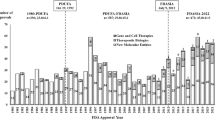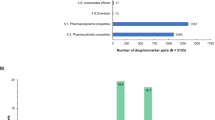Abstract
With rapid developments of pharmacogenomics (PGx) and regulatory science, it is important to understand the current PGx integration in product life cycle, impact on clinical practice thus far and opportunities ahead. We conducted a cross-sectional review on PGx-related regulatory documents and implementation guidelines in the United States and Europe. Our review found that although PGx-related guidance in both markets span across the entire product life cycle, the scope of implementation guidelines varies across two continents. Approximately one-third of Food and Drug Administration (FDA)-approved drugs with PGx information in drug labels and half of the European labels posted on PharmGKB website contain recommendations on genetic testing. The drugs affected 19 and 15 World Health Organization Anatomical Therapeutic Chemical drug classes (fourth level) in the United States and Europe, respectively, with protein kinase inhibitors (13 drugs in the United States and 16 drugs in Europe) being most prevalent. Topics of emerging interest were novel technologies, adaptive design in clinical trial and sample collection.
This is a preview of subscription content, access via your institution
Access options
Subscribe to this journal
Receive 6 print issues and online access
$259.00 per year
only $43.17 per issue
Buy this article
- Purchase on Springer Link
- Instant access to full article PDF
Prices may be subject to local taxes which are calculated during checkout



Similar content being viewed by others
References
Moghissi AS, Sorin R, Love, Betty R, Bride, Dennis K et al. Innovation in regulatory science: evolution of a new scientific discipline. Technol Innov 2014; 16: 155–165.
Kola I, Landis J . Can the pharmaceutical industry reduce attrition rates? Nat Rev Drug Discov 2004; 3: 711–715.
Eichler HG, Baird LG, Barker R, Bloechl-Daum B, Børlum-Kristensen F, Brown J et al. From adaptive licensing to adaptive pathways: Delivering a flexible life-span approach to bring new drugs to patients. Clin Pharmacol Ther 2015; 97: 234–246.
FDA. Innovation or Stagnation: Challenge and Opportunity on the Critical Path to New Medical Products 2004, Available at http://www.fda.gov/downloads/ScienceResearch/SpecialTopics/CriticalPathInitiative/CriticalPathOpportunitiesReports/UCM113411.pdf.
Venter JC, Adams MD, Myers EW, Li PW, Mural RJ, Sutton GG et al. The sequence of the human genome. Science 2001; 291: 1304–1351.
Nelson MR, Johnson T, Warren L, Hughes AR, Chissoe SL, Xu C-F et al. The genetics of drug efficacy: opportunities and challenges. Nat Rev Genet 2016; 17: 197–206.
Zineh I, Woodcock J . The clinical pharmacogeneticist: an emerging regulatory scientist at the US Food and Drug Administration. Hum Genomics 2010; 4: 221–225.
Toh DS, Tan LL, Aw DC, Pang SM, Lim SH, Thirumoorthy T et al. Building pharmacogenetics into a pharmacovigilance program in Singapore: using serious skin rash as a pilot study. Pharmacogenomics J 2014; 14: 316–321.
Shaw PM, Zineh I . Generating and weighing evidence in drug development and regulatory decision making: 5th US FDA-DIA workshop on pharmacogenomics. Pharmacogenomics 2010; 11: 1629–1635.
Ehmann F, Papaluca Amati M, Salmonson T, Posch M, Vamvakas S, Hemmings R et al. Gatekeepers and enablers: how drug regulators respond to a challenging and changing environment by moving toward a proactive attitude. Clin Pharmacol Ther 2013; 93: 425–432.
The European Medicines AgencyThe European Medicines Agency's scientific guidelines on pharmacogenomics (PG) help medicine developers prepare marketing authorisation applications for human medicines. Available at http://www.ema.europa.eu/ema/index.jsp?curl=pages/regulation/general/general_content_000411.jsp&mid=WC0b01ac058002958e.
The US Food and Drug AdministrationGenomics guidances, concept papers, and MaPPs. Available at http://www.fda.gov/Drugs/ScienceResearch/ResearchAreas/Pharmacogenetics/ucm083374.htm.
The US Food and Drug AdministrationTable of Pharmacogenomic Biomarkers in Drug Labeling. Available at http://www.fda.gov/drugs/scienceresearch/researchareas/pharmacogenetics/ucm083378.htm.
PharmGKBClassification on the level of genotyping levels implied on drug labels (PGx Level). Available at https://www.pharmgkb.org/view/drug-labels.do.
Lesko LJ, I Zineh . DNA, drugs and chariots: on a decade of pharmacogenomics at the US FDA. Pharmacogenomics 2010; 11: 507–512.
Innovation Task Force. Available at http://www.ema.europa.eu/ema/index.jsp?curl=pages/regulation/general/general_content_000334.jsp.
Phillips KA, Van Bebber SL . Regulatory perspectives on pharmacogenomics: a review of the literature on key issues faced by the United States Food and Drug Administration. Med Care Res Rev 2006; 63: 301–326.
Lazarou J, Pomeranz BH, Corey PN . Incidence of adverse drug reactions in hospitalized patients: a meta-analysis of prospective studies. JAMA 1998; 279: 1200–1205.
Ernst FR, Grizzle AJ . Drug-related morbidity and mortality: updating the cost-of-illness model. J Am Pharm Assoc 2001; 41: 192–199.
ICHGuideline on genomic sampling and management of genomic data (E18). Available at http://www.ich.org/products/guidelines/efficacy/article/efficacy-guidelines.html.
Ehmann F, Caneva L, Prasad K, Paulmichl M, Maliepaard M, Llerena A et al. Pharmacogenomic information in drug labels: European Medicines Agency perspective. Pharmacogenomics J 2015; 15: 201–210.
Tan-Koi WC, Lim ESH, Teo YY . Health regulatory communications of well-established safety-related pharmacogenomics associations in six developed countries: an evaluation of alignment. Pharmacogenomics J 2017; 17: 121–127.
Shimazawa R, Ikeda M . Differences in pharmacogenomic biomarker information in package inserts from the United States, the United Kingdom and Japan. J Clin Pharm Ther 2013; 38: 468–475.
Mallal S, Phillips E, Carosi G, Molina JM, Workman C, Tomazic J et al. HLA-B*5701 screening for hypersensitivity to abacavir. N Engl J Med 2008; 358: 568–579.
Chung WH, Hung SI, Hong HS, Hsih MS, Yang LC, Ho HC et al. Medical genetics: a marker for Stevens-Johnson syndrome. Nature 2004; 428: 486.
Tan-Koi WC, Kapoor R, Teo YY . Pharmacogenetics through a public health lens: from policy to practice. Pharmacogenet Genomics 2015; 25: 518–520.
Pacanowski MA, Leptak C, Zineh I . Next-generation medicines: past regulatory experience and considerations for the future. Clin Pharmacol Ther 2014; 95: 247–249.
Zineh I, Mummaneni P, Lyndly J, Amur S, La Grenade LA, Chang SH et al. Allopurinol pharmacogenetics: assessment of potential clinical usefulness. Pharmacogenomics 2011; 12: 1741–1749.
Green ED, Guyer MS . Charting a course for genomic medicine from base pairs to bedside. Nature 2011; 470: 204–213.
Roberts MC, Kennedy AE, Chambers DA, Khoury MJ . The current state of implementation science in genomic medicine: opportunities for improvement. Genet Med 2017; 19: 858–863.
AstraZeneca announces partnership with Illumina to develop next generation gene sequencing panel for companion diagnostic tests. Available at https://www.astrazeneca.com/media-centre/press-releases/2014/astrazeneca-illumina-gene-sequencing-panel-companion-diagnostic-tests-oncology-21082014.html.
Lumpkin MM, Eichler HG, Breckenridge A, Hamburg MA, Lonngren T, Woods K . Advancing the science of medicines regulation: the role of the 21st-century medicines regulator. Clin Pharmacol Ther 2012; 92: 486–493.
Acknowledgements
YYT acknowledges support from the Saw Swee Hock School of Public Health, National University of Singapore. YYT additionally acknowledges support by the National Research Foundation, Prime Minister’s Office, Singapore, under its Research Fellowship (NRF-RF-2010-05) and administered by the National University of Singapore.
Author information
Authors and Affiliations
Corresponding author
Ethics declarations
Competing interests
The authors declare no conflict of interest.
Additional information
Disclaimer
The views expressed in this article are the personal views of the authors and may not be understood or quoted as being made on behalf of or reflecting the position of the respective regulatory agencies or any of the committees or working parties.
Rights and permissions
About this article
Cite this article
Tan-Koi, W., Leow, P. & Teo, Y. Applications of pharmacogenomics in regulatory science: a product life cycle review. Pharmacogenomics J 18, 359–366 (2018). https://doi.org/10.1038/tpj.2017.47
Received:
Revised:
Accepted:
Published:
Issue Date:
DOI: https://doi.org/10.1038/tpj.2017.47



